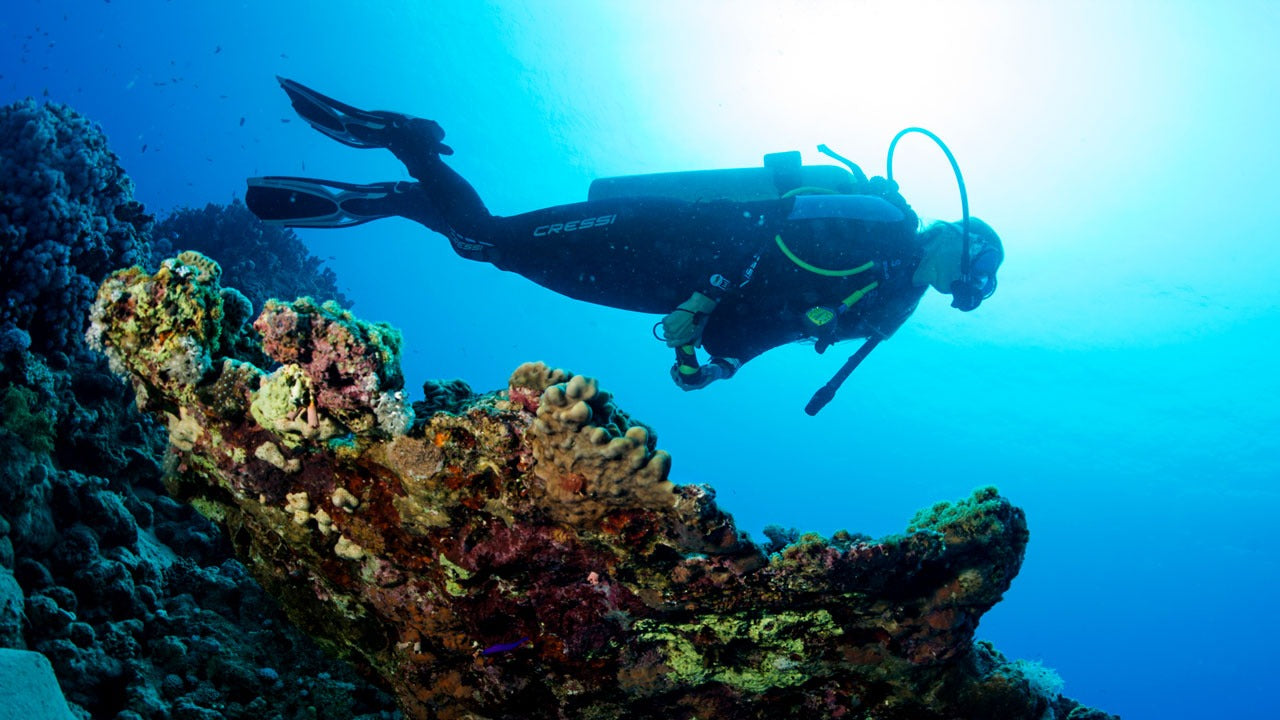The History of Diving

Since the dawn of human existence, we have been diving underwater. Divers have been searching the deep seas for food, riches, resources, and treasures since ancient Mesopotamia. It has improved significantly throughout the ages, with new equipment enabling safer and longer dives, as well as greater exploration of the deep waters. Every culture that has been inextricably linked to the water has had divers who were frequently held in high regard! The history of diving, as well as advancements in the pursuit, are owing to these courageous athletes. Although history has not left us with a definite record of the origins of diving, nor can we pinpoint a specific date, we do know a great deal thanks to the numerous surviving written records left by our forefathers. The evolution of diving has had quite a history.
The Earliest Divers
To throw some light on the old art of deep diving, we must first consult archaeologists' findings. While there are some written historical accounts from ancient Mesopotamia describing the art of diving, it is important to remember that many of these translations occurred in the nineteenth century by individuals who had only recently learned the language, and thus the concept of a "diver" may not be a direct translation. Rather than that, we look to the real artifacts left by civilizations to give additional light on the matter. Prior to 4400 BC, the era known as the "Stone Age," we have mostly educated guesses.
During this time period, diving is likely to have evolved gradually from humans who developed the ability to swim. Swimming was not practiced by all Stone Age tribes, and swimmers were often considered to be in a class of their own. Nonetheless, there are rock drawings in Egypt's sandstone plateaus that clearly depict people swimming at this time period, and cultures as far as three thousand miles distant made jewelry from corals that would have needed deep diving to acquire. Ancient cave drawings also appear to portray marine life forms such as crabs and shells that are only found at depths away from the shoreline and were only discovered if they were brought to the surface in some way.
Other archaeologists argue that the earliest form of diving took place in Denmark in 5300, as digs into the Ertebolle culture have found evidence of the gathering of oysters and pearls, which requires the ability to hold one’s breath and dive deep to retrieve the oysters. Refuse piles at these archaeological discoveries indicate that this civilization devoured a considerable quantity of subtidal oysters, and because subtidal oyster beds stay buried even at low tide, retrieving them would require diving beneath the ocean. Others claim that because these oyster beds are not sufficiently deep to prohibit someone from just holding their breath and rapidly sinking and rising, this does not constitute diving.
The Bronze Age not only encompassed the civilizations that existed between 4500 and 2400 BC, but also provides a deeper look into the possibilities of divers. At Ur, discoveries indicate a collection of mother-of-pearl oysters, red sandstone, and lapis lazuli. In comparison to subtidal oysters, mother-of-pearl oysters reside relatively deep and require true diving ability to recover. Additionally, the Sumerian language contains a word for diving called "ninri," which translates as "to dive" or "to sink." This indicates that ancient peoples ventured far beyond the shallow waters.
The earliest recorded account, the Epic of Gilgamesh, describes the trade of specific shells that were as rare and costly as gold due to the difficulty of getting them from the sea. Additionally, the 1790 BC Code of Hammurabi has rather specific laws about the payment of boatmen and the valuation of boats, including what should happen in the event that a boat is wrecked and the cargo lost. According to this rule, the boatman is required to compensate the owner for up to half the value of the cargo if it was not retrievable, probably through diving. Indeed, the Gilgamesh Epic makes reference to free diving to collect objects from the bottom of the sea, implying that this was a pastime or profession for individuals tasked with retrieving items from wrecked boats. Seafarers harvested cowry shells during low tide in the Old Kingdom of Egypt, as they were in high demand for jewelry and cash.
In his own writings, the poet Homer mentions sponge divers as early as 1000 BC, and the Iliad mentions diving for oysters. Perhaps some of the most famous of these ancient divers were Scyllias and his daughter Hydna, two Greeks who turned the tide of a naval battle during the Battle of Salamis. The Persian king, Xerxes, had dispatched over 200 ships to attack the Greeks, and on board one of the Persian ships was the expert diver and swimmer, and his daughter, whom he had also taught to dive. They had been hired by Xerxes to dive deep to retrieve some treasure from a shipwreck. Once the job was complete, the pair indicated that they wished to return to Greece, but Xerxes refused to let them go, stating that they were liabilities for knowing too much about Persian ships and their tactical maneuvers. With an oncoming storm rolling in, the Persian ships moored in a safe harbor, father and daughter escaped in the night, jumping overboard, but before making their escape, they swam amongst the ships with makeshift snorkels, cutting the moorings and allowing the ships to be tossed about by the waves in the storm. Crashing against each other, many boats were disabled or sunk. Reportedly, they then swam 15 km back to Greece.
With the tactical advantage of divers being a valuable asset in naval operations, the Spartans and Greeks began incorporating divers into their military strategy. Even before Christ's birth, accounts of Greek and Spartan divers described them swimming past naval blockades, smuggling food, passing tactical knowledge, and acting as spies. The Assyrians of 700 BC, archaeologists believe, were the first scuba divers, using a camel’s stomach as an airbag to breathe from. On the other hand, some archaeologists point to an Assyrian bas-relief depicting a soldier in armor swimming with an airbag and utilizing it as a float instead of breathing equipment.
Military diving was also utilized by Alexander the Great's army at the Siege of Tyre. Alexander employed divers to swim beneath the opposing vessels and cut their cables, as both Alexander and the Tyrians had armored their ships with mail. This left the enemy ships adrift and vulnerable to Alexander's forces.

Medieval to Modern Divers
An Egyptian named Ahsan-ul-Ghawasin is the one credited with inventing the first diving apparatus. This Egyptian inventor was a member of the Turkish Sultan Saladin's navy. Prior to the advent of diving breathing aids, divers had to develop the ability to hold their breath for an extended period of time at specific depths in order to finish dives. Some divers utilized snorkels, although they are ineffective after the diver descends to a depth where the snorkel is submerged. In al-Ghawasin's case, he devised a diving apparatus composed of bellows and large stones that kept the apparatus submerged beneath the surface, assisting in breathing. His innovation was one of the earliest examples of a diving helmet.
The Renaissance saw a surge in invention and scientific inquiry, and diving equipment also saw significant changes during this time period. Leonardo da Vinci, an inventor and artist, was one of the first to propose the use of air tanks to enable underwater breathing. He also drew some crude diving fins. Guglielmo de Lorena invented one of the earliest designs of the diving bell in 1535, allowing divers to reach the ocean floor in a container of air and salvage shipwrecks.
These early designs laid the groundwork for the successful, albeit crude, diving systems of the eighteenth century. In 1771, a Frenchman named Freminet invented the "hydrostatic machine" in Europe, which consisted of a metal helmet with eye holes. The inventors used leather to construct the semi-automatic helmet, and copper to construct the helmet. Two tubes connected the helmet to an air reserve, one for inhalation and one for exhalation. It enabled dives for around five minutes.
History of Diving Bells
Without a doubt, the modest instrument that would come to be known as the diving bell ushered in a whole new era of underwater research. The gadget operates similarly to an upside-down cup submerged in water, with the water pressure trapping the oxygen-containing air inside the chamber. Once this notion emerged, divers discovered they could essentially send down a bubble of air from which they might emerge, explore briefly, and then return for further air and exploration. The duration of the dive was no longer restricted by the amount of air that could be held in the lungs for an extended period of time.
In the fourth century BC, Aristotle writes about his pupil Alexander the Great descending to the ocean depths in a barrel made of white glass. Although de Lorena's invention improved on the design involving air tubes, it was the following generation of scientists, including Kessler, Sir William Phips, Abbé Jean de Hautefeuille, and Edmund Halley of comet fame, who gradually advanced the diving bell through the centuries. This resulted in our current understanding of diving technology. In 1681, Hautefeuille found that when one descends deeper into the bubble, the atmospheric pressure of the air changes.
Recognizing that the problem was caused by water, Halley devised a system of barrels, hoses, and valves for stabilizing oxygen and pressure inside a diving bell. Perhaps the most famous bell divers were Scottish confectioner Charles Spalding and his nephew Ebenezer Watson, who enhanced the diving bell by adding balance weights and a pulley system that allowed for greater control over the plunge. Unfortunately, while performing salvage operations off the coast of Ireland, both men died from suffocation inside one of their diving bells.
One of Spalding's most famous salvage operations was the HMS Royal George, which sank at anchor off the coast of Portsmouth on August 29, 1782. It was half submerged in 65 feet of water, posing a hazard to waterways, and the sinking was witnessed by Thomas Spaulding, Charles Spaulding's brother. Charles and his nephew were to begin salvage operations on the vessel using their diving bell, a large affair capable of seating two people. While the diving bell was not ideal for retrieving partially submerged vessels, there was enough detritus on the seafloor to warrant its usage.
The bell utilized in this instance could hold two people and was equipped with glass panes to allow for natural light. The bell could be lowered through a wire system and was equipped with a rope-based signaling system for rapid recovery. They were able to raise 15 cannons within a month of utilizing the bell, for which they were paid £400. However, it was Charles and Ebenezer's deaths that brought the operations to a halt. Salvage attempts on the George would resume in 1834, utilizing some of the earliest basic air pump diving helmets built by brothers Charles Anthony and Thomas Deane. At this stage, the ship's hull had partially dissolved, allowing for a greater retrieval of the debris. Using their rudimentary dive suit, the brothers found 28 guns and several other relics. Colonel Charles Pasley of the Army Corps of Royal Engineers finished the salvage operation in 1844.
The growing usage of diving bells enabled scientists to get a better understanding of the effects of pressure on the human body, which began to gain traction around 1900. The offshore oil business makes the most use of modern diving bells, which are pressurized platforms and diving chambers.
1930s and 1940s
Charles Anthony and John Dean's discovery of the diving helmet, which provided air via a hose, was a watershed moment in diving technology. By the nineteenth century, high-pressure gas and air cylinders enabled inventors to create compressed air breathing systems and the first scuba tanks. By the start of the twentieth century, diving tanks had developed a distinctive shape, similar to what they look like today. The regulator, the final component of the scuba equipment puzzle, was introduced in 1937. The BCD completed the modern diving equipment in 1971.
It's worth noting that, even as breathing apparatus evolved, goggles and fins remained rather primitive and were frequently homemade. In the 1940s, Guy Gilpatric, an American writer, produced what is regarded as the first sports diving textbook, The Compleat Goggler, in the world. It was a favorite book of a young man named Jacques Cousteau, who would go on to define scuba diving as a sport and a career. In 1942, a man named Costello invented the first gas chamber tank, which supplied air and the proper water pressure only when the diver inhaled. After patenting the world's first open-circuit scuba regulator, Cousteau invented the Aqua-lung, which changed the future of scuba.
1950s and 1960s
Scuba diving in its modern form most likely began around 1950. With the advancement of breathing apparatus, as well as the publication of books, films, and images depicting the underwater world, the sport of scuba has expanded. In comparison to today's standards, the equipment of the 1950s was still somewhat basic, with only double hose regulators available and buoyancy control devices still to be produced. By the mid-1960s, the majority of divers were employing single-hose regulators, wetsuits, and other commercially available gear.
Additionally, scuba diver training was either non-existent or in its infancy. There were no certification requirements for scuba diving teachers; rather, they were just more experienced divers, mostly military personnel, eager to share their hobby with others. Despite the basic nature of the equipment and training, significant milestones were achieved during this time period. It was during this era that the diving community recognized the critical nature of training in order to minimize the dangers associated with scuba and began developing its first certifications. The National Association of Underwater Instructors and the YMCA Scuba Program were among the first to issue diver and instructor certificates.
1970s to Present Day
For scuba, the late 1960s and 1970s are considered transitional years. This was the birth of the BCD, which took the shape of an inflatable collar vest that could be inflated either orally or with a CO2 cartridge. This provided divers, particularly cave divers, with the ability to adjust their buoyancy underwater. Further developments in scuba diver tanks and equipment enabled them to be mass-produced and more affordable, further democratizing the sport. Additionally, it was during this time period that the decompression meter was developed, which served as a precursor to the modern dive computer.
Still, the general perception of scuba has remained mostly unchanged, as many continue to view it as a sport reserved for the adventurous or hearty few. By the 1980s, however, the first jacket-type BCDs had become popular, and by the mid-1980s, the horse collar style had been phased out in favor of something far more comfortable and reliable, along with the dive computer. Training also began to adapt, with a greater emphasis on actual scuba diver abilities and a more rapid transition to open water, where you practice the skills under the supervision of an instructor. This allowed for even more "regular" people to join in the sport, and join the mainstream.
From the 1990s until the present, equipment and technological advancements have accelerated. Dive computers became more reliable and affordable, and digital technology such as DVDs and the internet increased the accessibility of video teaching. Scuba began to offer itself to the public as something that the majority of people with a reasonable level of fitness could accomplish. Scuba, too, has a bright future thanks to computer technology.
Recent technological advancements include electronic compass and navigation, heads-up displays integrated into dive masks, and underwater voice communication. Dive equipment continues to improve in terms of weight, efficiency, and compactness. Decompression technology for deep dives is also advancing, and the first pressurized hard suits for sport use are on the horizon. Without a doubt, diving in the future will be safer and more fun, opening up the oceans to exploration for everybody.




